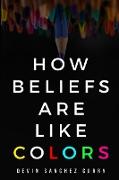how beliefs are like colors
BücherAngebote / Angebote:
Following Wilfrid Sellars, most philosophers consider beliefs to be theoretical entities.1 According to the standard view, ordinary people wield a folk psychological theory that purports beliefs to be cogs in cognitive systems, this folk psychological theory will be either vindicated or refuted by empirical investigation into the mind. Most adherents to the standard view are either mind-brain identity theorists-who hold that (types or tokens of) beliefs are identical to (types or tokens of) brain states (Place 1956, Feigl 1958, Smart 1959, Armstrong 1968, Lewis 1966, 1972, Polger 2004, Shapiro 2018)-or role functionalists-who hold that beliefs are identical to functional roles contingently realized by brain states (Putnam 1967, Block & Fodor 1972, Millikan 1984, Fodor 1987, Dretske 1988, Jackson & Pettit 1990, Cummins 1996, Carruthers 2006, Burge 2010, Quilty-Dunn & Mandelbaum 2017).2 Other adherents to the standard view are eliminativists, who wager that the folk psychological theory that posits beliefs will be discredited as cognitive psychology and neuroscience advance, and that beliefs therefore do not exist (P.M. Churchland 1979, 1981, 1993, Stich 1983, P.S. Churchland 1986, Ramsey, Stich & Garon 1990, Chemero 2009, Rosenberg 2016).
Folgt in ca. 15 Arbeitstagen

